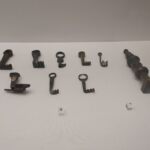Hardly anyone wonders how the ancients once closed their homes, chests or cells. As it turns out, a modern key or lock is an ancient invention. For example, castles made of strong wood were already used in Egypt or Greece. However, most of the locksmith’s “patents” come from Rome, which largely took over knowledge from the Etruscans.
Thanks to the excavations carried out in Pompeii and Herculaneum, scientists were able to better understand the daily life of the ancient Romans. The houses preserved in volcanic ash and their decor have allowed seeing many mechanisms and objects used in antiquity. The houses had wooden boxes or cabinets, which sometimes had locks to secure jewellery or other precious items. Despite the disaster of 79 CE, many chests still had content upon their discovery.
Ancient Romans are certainly the first civilization that began to use keys that are very similar to modern ones. It is made of bronze or iron, sometimes from a combination of them; strong wood or bones were also used. The keys to the locks were small, light and comfortable to grip by the ear. Interestingly, the Romans came up with an innovation, a combination of a ring with a key. This type of key was used for all kinds of small jewellery boxes.
A locksmith operating in the ancient world had to have great engineering knowledge and intuition, given that he did everything manually.
In the Roman world, efforts were made to move away from wooden cylinder locks in favour of their metal versions. The Romans additionally introduced metal springs in the mechanism and tried to get the best performance and appearance. It is worth adding that all Roman doors could be opened only on one side.
Another Roman invention that we use to this day was a padlock, which was built around 100-200 CE. Padlocks were cheaper than locks and easier to use, but more impractical to use because of the inconvenient way of closing and opening.
More photos and information are on pages in the source.










